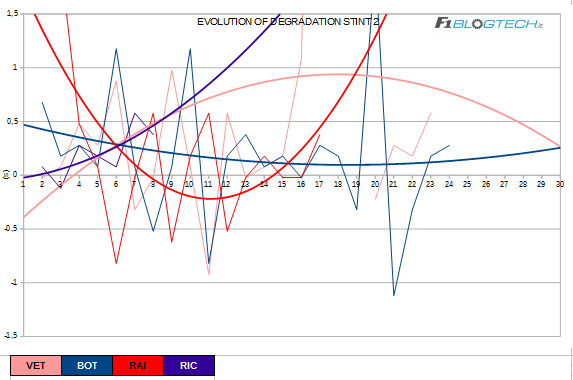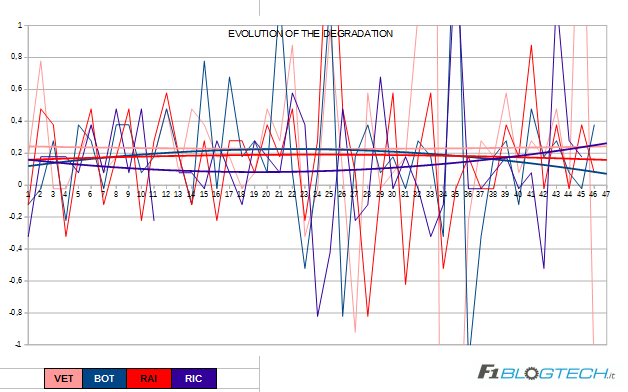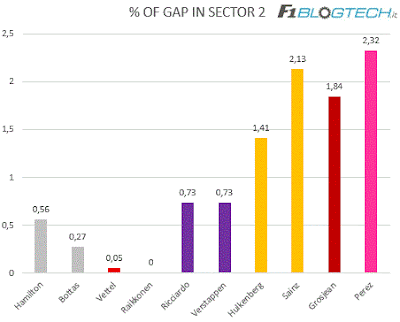TYRES' LOTTERY
Written by Gianluca Medeot
Shanghai, April 15th 2018. An eventful race that covered a qualification in which it has been outlined. an interesting but at the same time complex technical framework.
So, let's analyze what there is behind teams' performance ( we will consider the 10 car qualyfied in Q3).
In order to have a clearer and more effective analysis it is essential to outline the characteristics of the Chinese track: it is a medium / high downforce circuit and medium severity for thrusters (traveling at fully open throttle for approximately 56% of the lap).
The first sector is very slow and traction is critical. On the contrary, the second, is a fast sector with two large-radius curves in which much load and especially a correct aerodynamic balance are needed to prevent harmful phenomena of understeer. The third is instead formed by a stretch of 1.3 km where there is needed a lot of straight efficiency (the union between PU's power and cx), with a final section (the last and penultimate curve) in which traction is again very important.
The charts with percentages detachment from pole position don't provide us with particular issues for analysis, but they outline Mercedes' and Red Bull's negative trend of the last GPs. All the second range team maintain their trend , with the exception of Toro Rosso which gained a 3% detachment after the positive exploit in Bahrain.
The element that has probably influenced the most cars' performances during the weekend was definitely the continuous change of track temperature: 20° on Friday, 15° on Saturday (there were also gusts of wind) and 40° on Sunday. The thermal excursion was really high and very difficult to handle for the team, considering the very strice " temperature windows" in which the 2018 tires work. This element, combined with the length of the main straight, made very difficult for the drivers to keep the tires in this operating window.
From the graph with the comparison between the real times recorded in Q3 and "ideal" times we can see these difficulties. Only two Q3's drivers( Vettel and Perez) managed to score their best time in the crucial moment.
We must underline that Raikkonen had "in his foot" the chance to make pole position.
It is very interesting to analyze the maximum speeds recorded at the speed trap. It is very clear the differentation of set up between the two Ferraris, with Vettel who went for slightly lower load. The microsector map proposed by Fom, shows clearly the predominance of Vettel in the straights, that in chronometric terms pay a lot on this particular track.
Mercedes aligns to Ferrari datas confirming pairing in terms (on qualifying maps ) of power between the two PUs. This is a very important signal for Ferrari, which will now have to focus on the efficiency of race's mapping to avoid those stint in which drivers are forced to carry out an obvious fuel-saving.
Analyzing the percentages detachments in the different sectors, we can notice that the Ferraris are faster in every intermediate, but they really made the difference with the silver arrow in the first one
A detachment of more than one percent for both Mercedes drivers. A surprising data because in the second sector, which has practically identical characteristics, the gaps appear to be much more light.
The most plausible explanation could be a lack of temperature on the tires.
 This observation provides us the opportunity to briefly talk about the problem that I have mentioned before.
This observation provides us the opportunity to briefly talk about the problem that I have mentioned before.
In the Q2 Mercedes marked a super competitive lap with the Soft before improving only two tenths with the Ultrasoft. In Australia with Supersoft it was uncatchable in qualifying, but it then sunk in Bahrain always with the same compound.
Competitive within the averages in Bahrain, and fearful in China in mounting the Soft in the race fearing the an overheating.
It's clear that the main W09's problem (for now) is to keep the tires in the right temperature window.
Ferrari outlined very different behaviors in different Gp, but also between the different sessions.
So it is clear clear that the "tire factor" will represent a great wild cart in the 2018 championship because of the very tight operational windows of these new tires (at the bottom you will find a summary table of the different tires).
 It is difficult to give an explanation to such problems highlighted by Mercedes. If in fact the most rigid set-up dictated by the use of a less pronounced rake could justify the overheating phenomena with low working range tires, through the external analysis is more difficult to justify the problems to bring them to the temperature shown in China.
It is difficult to give an explanation to such problems highlighted by Mercedes. If in fact the most rigid set-up dictated by the use of a less pronounced rake could justify the overheating phenomena with low working range tires, through the external analysis is more difficult to justify the problems to bring them to the temperature shown in China.
Nothing to add for Ferrari which was perfect in the qualifying lap, precise insertion in curve and no signs of oversteer, all confirming the progressive refinement throughout the mechanical set-up carried out by the team.
 Important to mention the Red Bull that finally had the opportunity to show its potential in the race, waiting for a street circuit where it can really show off its frame capabilities, constantly hidden by the PU power gap.
Important to mention the Red Bull that finally had the opportunity to show its potential in the race, waiting for a street circuit where it can really show off its frame capabilities, constantly hidden by the PU power gap.
Looking at the graphs we can see that obviously the third sector is the one in which they lost more time, then settling in the first and second almost to the levels of Mercedes.
A remarkable data considering the very low angles of incidence of the wings used in order not to lose too much in a straight line (matched then with a pronounced rake and the use of a refined third hydraulic element that perfectly manages of the height of the car from the ground).
RACE'S GRAPHICS (edited by Niccolò Arnerich)
FRIDAY SIMULATION
Very low temperatures of the track during simulations made on Friday. The temperature of the asphalt roamed, in fact, about 14 ° C. From the long runs it has shown that the safest strategy was a one-stop strategy, starting with S before moving to M. This is because the UltraSoft seemed to have a rather high degradation, with an anticipated cliff, which would have addressed the race on two stops and not on one.
Ferrari and Mercedes have decided to qualify in Q2 with Soft tires, unlike Red Bull, who qualified with the US , to try the two-stop strategy.
The strategies were still very similar, as can be seen from the graph below, but the US was partly unknown because it was not sure he could make the strategy work at a stop sign.
We remind that the Pirelli decided to bring here Medium, Soft and Ultrasoft.
THE RACE STRATEGY:
TRACK CONDITIONS
Very different track conditions on Sunday. Temperatures were in fact much higher and fluctuated about 39 ° C.
THE START OF THE GRAND PRIX
Good start for Vettel who immediately went to forcefully close the door to Raikkonen. Bottas was then able to overtake the Finn into the first corner and this fact did gave the race a very different direction from the one that could have taken in terms of strategy, having two Ferraris in charge.
THE FIRST STINT
In the first stint Vettel managed to create a 3s gap on Bottas and both because he had clean air in front of him, and staying in the slipstream of another car for more laps was not very "healthy" for the W09.
Standing in the wash of another car causes infact an overheating of the compound, as well as an overheating of the components of the Power Unit, which causes a greater degradation of the compound and a rise in temperature.
Hamilton was close to Raikkonen just managing to get close before the stop.
Verstappen held a rhythm with the US worse than that of Ferrari and Mercedes on S. His pace was not good at all if you think that his strategy was marked by two stop and therefore, to make it work, he wshould have had to run on much fester lap-times. It can also be assumed that RedBull's pitwall was trying the one-stop strategy US-M, with an advantage during the starting phase thanks to the greater grip of UltraSoft, and that therefore the Dutch was trying to lengthen the life of this compound; eventually they definitely opted for two stops as their first stop took place too early, on lap 17. The Same was for the RB14 Ricciardo, who was also on the same strategy.
From the graph with the the fuel weight effect correction it is clear that Raikkonen has had a lower degradation compared to Vettel-Bottas couple, who has had a rather similar degradation, slightly more pronounced on the Finnish car. Ricciardo with the US, however, has suffered a much greater degradation.
THE SECOND AND THIRD STINT (OF REDBULL)
The first to stop to go to the second stint were the Red Bulls. For both drivers it was mounted a M in a double pit stop. Ricciardo has also earned the position on Raikkonen, who has been out for much longer on the Soft tire.
Raikkonen stayed out until lap 27 to try to have an advantage in the last stint, on average, after the undercut tested by Hamilton had worked. Because of that he lost his position both on Hamilton and Ricciardo. He later had the advantage of having a new tire when the group was bunched up because of the lap 31 SC.
Looking at the Vettel-Bottas couple in command, Mercedes' strategists , under the command of James Vowles, decided to try the undercut with Bottas, then having a stop on lap 19. The undercut on paper was very difficult because the gap was well-over 3s. Bottas, however, did a very good lap and, helped by slow stop by Vettel in the next lap (1s exact total more slow times are measured in pit lane), he came out ahead of the German who, in later rounds, tried invain to overtake on the track. Plus, by analyzing Vettel's lap, it can be noticed that the rubber began to degrade and therefore most a few tenths were lost at this stage. The Ferrari's wall would have to defend itself before stopping their driver and neutralizing Mercedes' undercut attempt.
On lap 31 the SC entered for the contact in corner 14 between Hartley and Gasly. This was the golden opportunity for the two RedBull that, by stopping, lost less time for the second pit stop and found themselves with a fresh S tire for the final stint. Vettel, Bottas and Hamilton have not taken advantage of this SC because when output had already passed what the team called "Safety Car Line 1" that is the pit entry.
Both Ferrari and Mercedes failed to show the delta between the two compounds that is very important to determine the stop. On paper the ground lost with this option will not balance positions theoretically gained later so they had to stay out.
Hence Ricciardo's and Verstappen recovery which leads the Australian to win the grand prix. The two Mercedes and Vettel still had the Medium rubber which was less performing than the Soft in that arc race.
Highlighting Ricciardo's comeback in the central part of the graph who lifted his time managing the gap created. It is also known as Vettel has greatly raised its timing, because of the Medium degradation, and especially at the end of the stint because of the floor's damage (caused by the contact with Verstappen).
We can notice from these graphs of the degradation that the Mercedes made better use of the compounds with higher temperature window, between 100 ° and 140 °, much higher compared to compounds such as the US or the SS. The compounds are very sensitive and to work well they must remain in their proper range. A few degrees can therefore significantly change car's performance. Mercedes is having some problems from this point of view also in the race, but the problem is reduced with higher range compounds.
Here, instead, the chart representing the steps race with the correction of the Fuel Weight Effect namely the loss of weight due to fuel consumption during the race.
Another very useful chart to see the actual degradation that has had the tire during the race.
THE MINOR TEAMS
Now, as always, we will examine the graphs for some teams that stand out during the Chinese GP. The charts then take into account the whole race Hulkenberg, Alonso, Magnussen and Ocon.



































